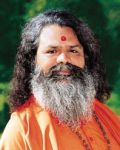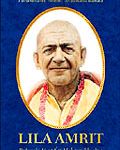Introduction
God is existent within each and every living being and as humans we have the possibility to realise our Divine descent. Yet only a rare few know of this inner treasure and set out to find it.
In all religions, worshipped as Saints, are those great Souls who have directly experienced God and dedicated their life to Him. But there is one fundamental difference between the Eastern and Western way of thought. In the West, these great Souls are acknowledged as Saints only after their death and not during their lifetime. Whereas in the East, the idea of a living Saint is absolutely conceivable — indeed fervently prayed for. God hears the prayer of His devotees and fulfils their wish through the birth of a Saint, so that the ordinary person too, may directly experience Him.
One such Saint was Bhagwan Sri Deep Narayan Mahaprabhuji, who lived from 1828 to 1963 in the state of Rajasthan, of North-West India. He was revered by thousands and many still live today who knew and worshipped him. Through his grace and blessing, God inspiration and God awareness was brought to many who had the privilege of meeting him. In the spirit of his teachings on Love and Truth, we begin to realize the true purpose and meaning of our human existence: to Love, Serve and Realize the Self.
In India, it is customary to show great veneration not only to Saints and Divine incarnations, but also to the spiritual teacher or mentor. It is through that person the spiritual aspirant obtains the valuable gift of Self-knowledge and Self-realization. Therefore, I wish to briefly comment on the terms used when speaking of that relationship between Master and Disciple.
In the Sanskrit language, a teacher or Master is called the Guru. 'Gu' means darkness and 'ru' means light. It is the Guru who leads us from the darkness of ignorance to the light of knowledge. The Sanskrit word for disciple is shishya and this term infers complete and perfect devotion. The disciple yields the ego and is willing to undertake all to reach the goal. The realized spiritual Master is called brahma nishtha shrotria Satguru. This means that the Master possesses perfect control over the body, mind and senses - their path to God-realization has been completed and this transcendent knowledge can be imparted to others. The Satguru knows the teachings and Holy texts through personal experience and in this way conveys these to the disciple.
There are two types of Master. One gains perfection and God realization through long and arduous practice, being led to this perfection by his own Master. The other type of Master is born perfect — already born as a Master. The latter is a higher being, who incarnates with perfect abilities and who is thus described as a Divine Soul. The Master who has obtained a higher level of consciousness through persistent effort and practice is called a yogi, but that one who already possesses supernatural abilities from birth is called a mahasiddhyogi. Some worship their own personal God in the mahasiddhyogi and other spiritual seekers who are free thinkers, simply see the Master in the mahasiddhyogi.
No Master will ever boast of their wondrous abilities or deeds, nor describe themselves as the source of the highest power — not even if that Master does possess siddhis (supernatural abilities). Each Master acknowledges God as the source of all knowledge and all power, no matter whether one refers to God as the Omnipresent, or God as that personal form of his own Divine Master.
God the Supreme, may appear to us in two ways. One form of the Supreme, is God the Omnipotent, who is everywhere in everything — this aspect of God is formless. The other aspect of God, is God with form, the incarnated God-power. However, if we wish to grasp God with our intellect, it is rather like trying to pour the vast ocean into a teacup. Nevertheless, we still dare attempt intellectual explanations of God!
So how is the power of God, or the Divine will, manifest and displayed in human form? Such an incarnation accomplishes deeds which reach far beyond the capacity of the ordinary human being. Under His mercy, fire is transformed into ice, illness into good health, death into life. He knows the desire of every soul and is able to fulfil that desire. He knows our inner Self. His power has no limit. He is able to appear in several places at one time. He always was, always is and always will be. However, due to the barriers of our limited intellect and ego, we are denied this understanding and realization. Only through love may this be realized: God is Love and Love is God. The Universal form of the Divine is love and this love manifests as beauty in creation. Love and beauty always radiate from the presence of the Master.
What is a disciple? The disciple is one who seeks the knowledge and realization of his or her true Self. A disciple beginning the journey of spiritual evolution, does also possess those same qualities and abilities as their Master. Yet these are unknown and buried deep beneath layers of ignorance. The consciousness of the disciple is filled with illusion and delusion and so one feels helpless. It is tremendously difficult to be a disciple! The task of the disciple is even more difficult than that of the Guru, for it is not easy to surrender the small but very powerful ego.
Knowledge is infinite, it has no boundary and is gained only through practice and personal experience. In every phase of life, a teacher is needed in order to learn something. Therefore, to gain spiritual knowledge a spiritual Master is required. The disciple approaches the Master because of his or her quest for enlightenment, just as the thirsty person carries their water jug to the source of the water. The disciple should have complete trust in the Master and be firmly convinced that the Master will fulfil their desire for Self-realization.
The Master is the one who gives, the disciple is the one who receives. Master and disciple are like two candles. The Master is that candle whose flame brightly burns and the disciple is that candle which is yet unlit. For the flame of the disciple to burn, the disciple must come to the flame of the Master. This means to follow the words of the Master and learn.
Yoga is no ritual, but there is a series of systematic exercises to be followed and if practised with trust, disciplÌne and firm determination, these will lead to enlightenment: to God-realization. The exercises and techniques that the Master teaches the disciple, are from that ancient knowledge which has been passed down from Master to disciple for many thousands of years.
Paramhans Swami Maheshwarananda
Next: Preface








